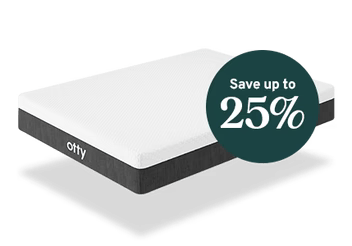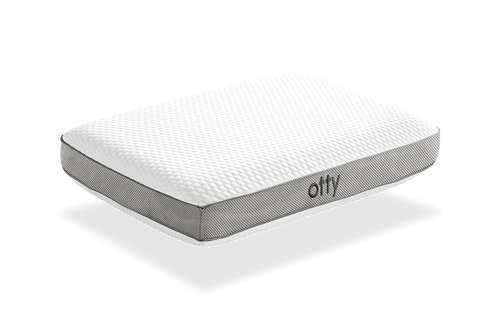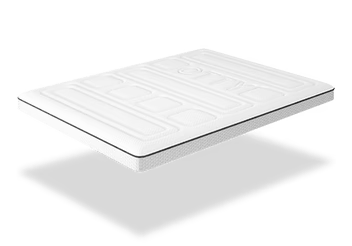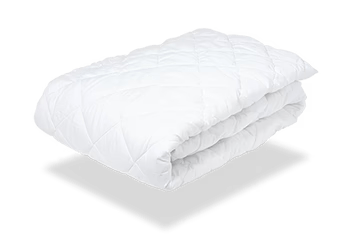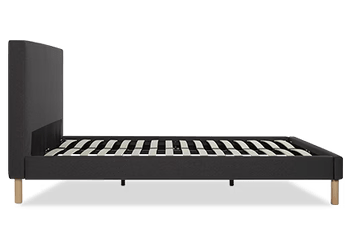Written By: Michal Szlas - Founder and CEO of Otty Sleep

If you're a hot sleeper, you're likely familiar with the discomfort of waking up in a sweat, especially during those balmy summer nights. Memory foam mattresses, while offering fantastic pressure relief, are notorious for their heat retention properties.
But don't despair! There are effective ways to combat this issue and ensure a cool, comfortable night's sleep.
In this guide, we delve into the science behind memory foam mattresses and why they tend to trap heat. We'll then explore various strategies to keep your mattress cool, from buying a cooling mattress, using cooling mattress toppers and pads to investing in breathable sheets and pillows. We'll also share tips on how to maintain a cool body temperature throughout the night, ensuring you wake up refreshed and ready to seize the day.
So, whether you're an existing memory foam mattress user or considering making the switch, this guide is packed with practical advice to help you sleep cooler and improve your overall sleep quality.
Let's dive in!
Why Do Memory Foam Mattresses Retain Heat?
Memory foam, known for its squishy texture and pressure-relieving properties, has gained popularity for its ability to contour to the shape of your body. This unique material works by displacing tiny air bubbles within its structure when pressure is applied, creating a moulded, personalized feel. However, despite its comfort, memory foam comes with significant drawbacks.
Why We Don’t Offer Full Memory Foam Mattresses
Full memory foam mattresses are notorious for retaining heat and moisture. Their dense structure limits airflow, trapping body heat and causing the surface to become uncomfortably warm during sleep. Additionally, memory foam’s lack of breathability can lead to moisture retention, which may create a clammy sleeping environment and, over time, affect the mattress's hygiene.
Why Hybrid Mattresses Are Superior
At OTTY, we exclusively offer hybrid mattresses that combine memory foam with pocket springs to address these issues. Hybrids use less memory foam, which helps improve airflow and significantly reduces heat retention. The pocket springs create gaps within the mattress, promoting better ventilation and ensuring a cooler sleeping surface.
Innovative Cooling Features
To further enhance temperature regulation, we perforate the top layer of foam in our mattresses. These perforations allow air to circulate more effectively, preventing heat and moisture from becoming trapped. This design ensures a cooler, drier, and more comfortable sleep experience throughout the night.
By choosing a hybrid mattress like ours, you can enjoy the pressure-relieving benefits of memory foam without sacrificing airflow, temperature regulation, or overall comfort. This thoughtful design is why we do not compromise with full foam options.
Using Cooling Mattress Accessories
Invest in a Cooling Mattress Topper
OTTY toppers are specifically designed with these features to enhance your sleep experience. Made from advanced materials like memory foam or latex, our toppers significantly improve the cooling properties of your mattress. They are crafted to dissipate heat effectively, providing a cooler and more comfortable sleeping environment. With OTTY toppers, you can upgrade your mattress and enjoy a refreshing night’s sleep, thanks to our innovative cooling technology.
Opt for a Topper with Conductive Materials
Opt for a topper with advanced conductive materials like those found in OTTY toppers. Our toppers are infused with innovative materials such as charcoal and bamboo, specifically designed to draw heat away from your body and maintain a cool, comfortable sleeping surface. These features make OTTY toppers the perfect addition to enhance your sleep environment with cutting-edge cooling technology.
The goal is to create a cool and fresh sleeping environment. By using cooling mattress toppers and pads, you can transform your sleep without having to replace your entire mattress.
Invest in Cooling Sheets and Pillows
At OTTY, we offer a range of breathable sheets and pillows designed to complement your memory foam mattress and help you sleep cooler. Investing in these can make a noticeable difference in temperature regulation. Transform your sleep setup with our specially designed cooling accessories for a more refreshing night’s rest.
Material
At OTTY, we offer bedding made from hypoallergenic, breathable natural fibers like cotton and linen. These fabrics are designed to promote airflow, allowing air to circulate and helping to reduce the temperature around your head and neck for a cooler, more comfortable sleep. With OTTY’s high-quality bedding, you can enjoy the perfect combination of comfort and breathability.
Pillow Type
OTTY pillows offer all of these advanced features to ensure a cooler, more comfortable sleep. Our pillows are filled with premium materials like shredded foam, which allows better airflow compared to solid memory foam, and incorporate innovative cooling technologies such as bamboo and charcoal infusions. These materials are specifically designed to wick away heat and maintain a cool surface throughout the night. By choosing OTTY pillows, you’re investing in a perfect blend of comfort, support, and cutting-edge cooling technology for a better night’s sleep.
By investing in cooling sheets and pillows, you can significantly enhance the coolness of your memory foam mattress. Remember, a cooler head and neck can lead to a cooler body, making your sleep more comfortable and restful.
Does Gel Infused Memory Foam Work?
Gel bead-infused memory foam was once marketed as a breakthrough for cooler sleep, but in reality, it offers only marginal improvements in temperature regulation. Memory foam technology has advanced significantly since gel foams were first introduced. At OTTY, we use the most advanced cooling foam available on the market today. Our innovative foam is designed to regulate body temperature more effectively than outdated gel-infused alternatives, ensuring a cooler and more comfortable sleep experience without relying on gimmicks.
Hybrid Memory Foam Mattresses
Hybrid memory foam mattresses will still usually offer the sleep benefits of memory foam but will often take away the negatives - heat retention - due to a mixture of other materials.
We particularly recommend encapsulated pocket springs and memory foam combinations - the base of all OTTY mattresses, which will provide excellent support due to the long springs, comfort and that mould-to-your-body feeling from memory foam, but due to springs having plenty of air circulation, the combination helps to massively reduce heat retention and therefore, keeping you cooler at night.
Other Ways to Keep Cool While Sleeping
In our quest for a good night's sleep, we often overlook the importance of maintaining a proper bedroom temperature. This section will explore various strategies to help you sleep cooler and improve your overall sleep quality. From adjusting your sleep environment to choosing the right sleepwear, these tips are designed to enhance your sleep health and provide a more comfortable night's rest.
In the realm of holistic sleep wellness, understanding how to regulate your body temperature can make a significant difference, especially if you're a hot sleeper. So, let's dive in and explore these cool sleep strategies.
Adjusting Your Sleep Environment
Improve Airflow: Keep a window open or invest in a small circulating fan to maintain good airflow in your bedroom. Consider a bed foundation or a slatted bed frame design to enhance airflow around your mattress.
Light Control: Turn off bedside lamps, overhead lights, and other electronics well before bedtime. These devices generate heat when turned on, and switching them off can help reduce room temperature.
Air Conditioning: Use air conditioning on hot nights. While it can be costly, the benefit to your sleep quality may be worth the expense. Aim for a bedroom temperature of around 15 degrees.
Bedding Material: Opt for breathable, natural fibres like cotton, linen, silk, or bamboo for your bedding. These materials promote cooler temperatures and assist with your body's natural temperature regulation process at night.
Choosing the Right Sleepwear
Choosing the right sleepwear can significantly influence your sleep temperature. It's not just about what feels comfortable, but also what helps maintain a lower temperature throughout the night. Breathable, lightweight materials such as cotton or thin wool are ideal choices. These fabrics allow air to circulate, preventing heat from being trapped against your skin.
For some, the ultimate cool-down strategy might be sleeping in just their underwear. This minimal approach allows maximum skin exposure, promoting heat dissipation. However, it's essential to ensure your underwear is also made from breathable materials to avoid discomfort.
Remember, the goal is to enhance your sleep quality by maintaining the optimal temperature. So, choose your sleepwear wisely. It's not just about fashion or comfort, but also about sleep health. As a hot sleeper, the right sleepwear can make a world of difference.
In the realm of bedtime hygiene, the knowledge of sleep health extends to every aspect of your sleep environment, including your sleepwear. So, don't underestimate the power of the right pyjamas in your quest for quality sleep.
The Role of Hydration in Sleep Temperature
Hydration plays a pivotal role in maintaining a cool temperature during sleep. It's a key factor that often gets overlooked in the quest for quality sleep. As a hot sleeper, you might find that your body tends to heat up during the night, disrupting your sleep cycle. This is where hydration comes into play.
Drinking plenty of water throughout the day can help regulate your body temperature, keeping you cooler during the night. However, it's important to avoid drinking large amounts of water right before bed. This could lead to frequent wake-ups for bathroom trips, disrupting your sleep.
The goal is to achieve a balance. Too much hydration can lead to night sweats, while too little can leave you feeling parched and hot. So, it's all about finding the right amount of hydration that works for you.
Can Your Bed Base Make a Memory Foam Mattress Cooler?
Choosing the right bed base for your mattress is a crucial step towards achieving a cooler and more comfortable sleep. The bed base plays a significant role in regulating the temperature of your sleep surface, especially when using memory foam mattresses known for their heat-retaining properties.
A well-chosen bed base can enhance airflow, helping to dissipate the heat and moisture that memory foam tends to trap. This section will guide you through the importance of a breathable bed base and the materials to consider for your bed base.
The Importance of a Breathable Bed Frame
The bed base you choose for your memory foam mattress can significantly impact the overall temperature of your sleep surface. A breathable bed frame is crucial for maintaining a cool and comfortable sleeping environment.
The reason behind this is simple. A bed base with ample space underneath allows for better airflow. This increased circulation helps to dissipate heat and moisture that can get trapped within the mattress.
This is particularly important for memory foam mattresses.
By opting for a bed base that promotes airflow, you can mitigate this issue. The result is a cooler, more comfortable night's sleep.
So, when choosing a bed base for your memory foam mattress, consider its breathability.
Materials to Consider for Your Bed Base
When it comes to choosing materials for your bed base, there are a few key options to consider:
Wooden Slats: These are a great choice for memory foam mattresses. They provide ample space for air to circulate, helping to dissipate heat and moisture. Plus, they're sturdy and durable.
Metal Frames: While not as breathable as wooden slats, metal frames can still offer decent airflow. They're also robust and long-lasting.
The material of your bed base can significantly impact the temperature of your memory foam mattress. So, choose wisely to ensure a cool and comfortable night's sleep.
Why Hybrid Memory Foam Mattresses Are Good For Staying Cool
Hybrid mattresses, which combine the supportive pocket springs with the contouring comfort of memory foam, are an ideal choice for those who overheat at night.
The addition of springs enhances airflow, promoting better ventilation and preventing heat buildup, while the memory foam layer provides pressure relief and comfort.
This combination, which is the base of all OTTY mattresses ensures that you enjoy the cooling benefits of increased air circulation without sacrificing the supportive and body-conforming properties of memory foam. As a result, hybrid mattresses offer a balanced sleep environment that helps regulate temperature, keeping you cool and comfortable throughout the night.
Final Thoughts on Cooling Your Memory Foam Mattress
In conclusion, memory foam mattresses, while offering superior comfort and pressure relief, can often trap body heat, disrupting your sleep quality.
However, with the right strategies and accessories, you can significantly improve the temperature regulation of your bed. Investing in breathable materials like cotton, linen, or bamboo for your bedding and sleepwear, using cooling mattress toppers or pads, and considering mattresses with gel infusions or other cooling technologies can all contribute to a cooler sleep environment.
Remember, achieving optimal sleep health is about more than just comfort; it's about creating the right conditions for your body to rest and rejuvenate. So, don't let a hot sleeper situation compromise your sleep wellness. With the right knowledge and tools, you can enjoy the benefits of memory foam without heat retention.
